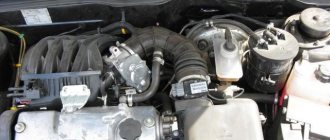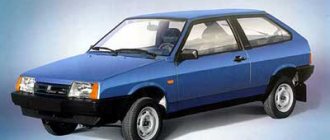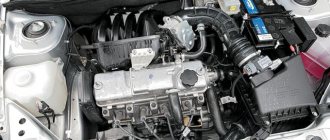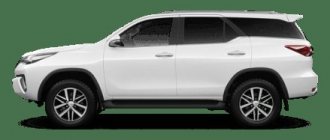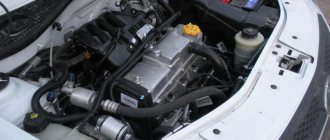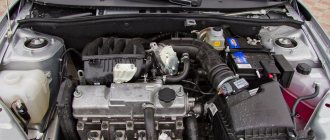The fourteenth model was first released for sale in 2002. In fact, this is an updated “nine”, which is loved by many car enthusiasts in the post-Soviet space. Improved appearance and technical equipment have significantly expanded the tuning possibilities.
In this article we will look at the main technical characteristics of the model, and you will also find out how much the VAZ-2114 weighs.
Technical specifications include:
- Aerodynamics.
- Dimensions.
- Clearance.
- Vehicle weight.
- Suspension features.
- Body information.
- Transmission.
- Engine performance.
Have aerodynamics improved compared to its predecessor?
The VAZ-2114 has improved aerodynamic characteristics thanks to modified body lines that provide good streamlining. This significantly reduced counter resistance while driving.
Aerodynamic improvements have affected the air mass separation point. To do this, we changed the angle of the hood and worked with the wings.
The result of the improvements is that air masses are now directed under the bottom to a lesser extent. Most of the flow goes to the hood and body. Accordingly, the lift force indicator changed, and both axles were unloaded. Now the driver can feel more confident when driving at high speeds.
see also
Comments 16
330 kg turned out
I also sold it without a roof for 2k, with the price of metal being 6.5r/kg
everywhere? Some of us also have 5. There are also 7, but there the scales are twisted too much))
yes, if you take the current to the city
at a price of 7-8 rubles per kg they give about 2-2.3 k for a bare body. cut into pieces. This makes it easier to transport and weigh
If the body is alive, they can buy a quarter or anyone who needs anything (left glass, roof, rear part), and this is more expensive than scrap metal
It’s a long time and he’s bothering me...
they seem to cost more in pieces)
from a penny entirely without doors and hood - pulled 330 kg, from 10 I don’t know
They accept bodies, don’t listen to anyone, you’ll just have to look where. I personally went there to hand over the metal - there was a gantry crane and scales on a hook, and workers there cut the bodies with a cutter and loaded them into the wagons right away. In small caricatures this may not be accepted, but in general they may require some kind of paper, a passport 100%. I didn’t hand over the body itself, a friend had been carrying a penny for a long time, he didn’t even ask about the weight.
Firstly, they won’t accept a whole body for scrap metal, they even take it in pieces with reluctance. And secondly, where metal is accepted, there should be scales that weigh the truck with metal on board at the entrance and without metal at the exit, and they pay the difference, and who even needed your weighing?
They are unlikely to accept it whole; they will have to cut it anyway. So you can do this and weigh it on a relatively small scale. I disassemble cars myself, I give advice) It is necessary to at least dismember them into 4 parts. two large circles for a grinder should be enough
Thank you, but here at our house they accept small Soviet scales, I’m from the region 100 km from Ryazan
The most common vehicles in the post-Soviet space have always been considered to be the products of the Volga automobile industry. These cars faithfully served their owners for decades. Therefore, the question of how much a VAZ 2107 weighs for scrap metal does not surprise anyone. The same applies to other car models that are subject to recycling.
The Lada Seven, according to documents, has a mass of 1049 kg. However, its weight is practically no different from any other brand of car from the Volzhsky Automobile Plant. The average weight of this Soviet car, which is often scrapped, is around one ton.
Sometimes owners of relatively new cars have to go to a metal collection point. The vehicle may be damaged as a result of an accident or other accident. In some situations, from an economic point of view, the only right decision would be to scrap the car.
Sometimes drivers prefer to disassemble the car themselves. Therefore, the relevance of the question of how much a VAZ 2101 body weighs for scrap metal is understandable. Considering that Kopeyka is the oldest representative of this line of the domestic automobile industry, it is the leader among cars that can be recycled. Its scrap weight is 955 kg, of which the body takes up about 280.
Exterior changes
The interior was updated with a European dashboard, an adjustable steering wheel and a completely new heating system. The rear seats can be folded down to create a larger trunk if needed.
Additionally, the VAZ-2114 is equipped with the following options:
- Electric windows.
- Heated seats.
- Central locking.
- Factory tinting in accordance with GOST requirements.
- The sills have fairings and moldings.
- Alloy wheels.
- Fog lights.
The maximum configuration of cars comes with an on-board computer that displays the following information:
- Average driving speed.
- Gasoline consumption.
- Travel time.
- Outside air temperature.
- Vehicle electrical network voltage and many other parameters.
Transmission and chassis
All front-wheel drive cars of the VAZ family have a fundamentally similar chassis design. The front suspension is based on the MacPherson system, the rear suspension is a trailing arm. The steering, typical for all models, is rack and pinion.
Lada 2114 Samara-2 is equipped with a manual gearbox. The car is equipped with a five-speed gearbox (gearbox) with a rocker drive. Fundamentally, its design is similar to all those installed on other vase models. The main pair has a distinctive gear ratio of 3.7.
A few words about technical characteristics
The VAZ-2114 hatchback differs from previous models in the following parameters:
- The length of the five-door body is 4122 cm.
- Width – 1650 cm.
- Height – 1402 cm.
- Unlike the base model 21093, the car has become slightly longer.
- Weight – 985 kg. The weight of the loaded vehicle is 1410 kg.
- Towing trailers without brakes - weight no more than 300 kg, with brakes - 750 kg.
- The wheelbase is 1.4 m (front wheels).
- 1.37 m (rear wheels).
- Trunk volume – 330 liters. With seats folded down – 600 liters.
- The clearance to the crankcase is 16 cm, to the pan it is a centimeter more.
Maintenance schedule
To avoid having to carry out expensive overhauls of the Lada Samara 2114 yourself, you should follow the manufacturer’s recommendations for servicing the internal combustion engine:
| Maintenance object | Time or mileage (whichever comes first) |
| Timing belt | replacement after 100,000 km |
| Battery | 1 year/20000 |
| Valve clearance | 2 years/20000 |
| Crankcase ventilation | 2 years/20000 |
| Belts that drive attachments | 2 years/20000 |
| Fuel line and tank cap | 2 years/40000 |
| Motor oil | 1 year/10000 |
| Oil filter | 1 year/10000 |
| Air filter | 1 – 2 years/40000 |
| Fuel filter | 4 years/40000 |
| Heating/Cooling Fittings and Hoses | 2 years/40000 |
| Coolant | 2 years/40000 |
| Oxygen sensor | 100000 |
| Spark plug | 1 – 2 years/20000 |
| Exhaust manifold | 1 year |
If consumables are replaced within the recommended time frame, the operational life of the internal combustion engine will increase.
Features of the internal combustion engine on the VAZ-2114
The very first cars of this modification came with a 1.5 liter engine. Their power was 57.2 kW.
In 2007, they began installing a 1.6-liter four-stroke engine with an output of 80 horsepower. This internal combustion engine complies with EURO-3 parameters. The latest modification of the fourteenth model is available with a sixteen-valve engine that develops a power of 89 hp. With.
Acceleration to 100 km/h is 13 seconds, which was achieved through distributed injection. The maximum speed of the VAZ-2114 is 160 km/h with a fuel consumption of 9 l/100 km in the city.
It is important to note that the ceramic catalyst is located next to the engine, which was not the case in previous models. The designers changed the cylinder block, increasing their volume and height (by 0.23 cm).
Body geometry
Body for VAZ 2114 and its tuning with your own hands
Many owners of the 14th model, driving a car for many years, do not even suspect how important the correct body geometry can be. But, in reality, this is the most important factor on which the performance and driving characteristics of the car depend. Without knowing what the overall body geometry is, there will be no way to check it. In addition, it will be useful to know what affects the violation of geometry dimensions, in what cases it changes, etc.
Geometry and what it is
In the automotive industry, geometry is usually called the “integrity” of dimensions between the main points of the body, standardly installed by the manufacturer. This is the most perfect position of all elements. If any discrepancy is observed, the operation of the components and mechanisms will no longer move in the right direction, since they are attached directly to various body parts. Needless to say, this will have an extremely negative impact on security.
Body geometry
The word body geometry on hatchbacks usually means the following distances:
- Between certain points of doorways (diagonals, height and width);
- Between the points of the hood and engine compartment.
On sedans, these indicators are supplemented by the standard trunk dimensions for the VAZ 2114.
Experts call the most important distances between control points of body parts associated with components and mechanisms of the chassis system. For example, these are the distances between the spars or glasses.
The accuracy of geometric dimensions will have a positive effect on additional parameters that are no less important in terms of increasing the convenience of driving characteristics and their safety. How does a geometry violation occur?
Why does the body geometry change and how is the check carried out?
Integrity of body geometry
The causes of body damage are not always accidents. If the owner often drives on uneven roads and various kinds of obstacles periodically appear on his way, changes in the geometry of the car body can be expected soon.
Of no small importance, of course, is the degree of damage, which entails a change in size. The more a certain part is subjected to deformation, the more the geometry of the body as a whole changes.
Checking the conformity of the body to the geometric dimensions is a very important component, which the vehicle owner is not always able to carry out independently. The fact is that changes may not be immediately noticeable at first glance. The car body tends to deform gradually, without “signaling” about it.
Today, most often, an inspection is carried out before purchasing a car, especially if it has a high mileage. A competently carried out procedure helps to avoid many problems, find out whether the car has been in an accident, what is the degree of deformation of various parts, and so on.
Violation of geometry and editing on the slipway
Sometimes, the geometry of the body is checked for another purpose: to determine the quality of the body repair, which the seller informs the buyer in advance. Here you need to be very careful, since a beautiful appearance does not always indicate the competence of the restoration work. It is extremely difficult to restore a car correctly after an accident, and only specialists can handle this matter well.
Note: Restoring body geometry may involve completely replacing parts or pulling them out on a stock pile using cold or hot methods.
It is recommended to check the condition of the body periodically. This must be done at least once a year, and if the car is often driven on bad roads, then twice or more.
You can check the condition of the body at home, using only a regular tape measure. It is better to measure the main distances, such as diagonals, first.
If you need to get more accurate information, then you need to contact the service station. Here, compliance will be checked using special equipment. Let us note right away that the procedure is not cheap, but it will pay off if the work is carried out in a high-quality service station. The fact is that in often cases, other problems of the car are determined by the geometry of the body. For example, it happens that even despite new chassis parts, the parameters for adjusting camber and toe are no longer adjustable. In this case, the root cause is found, after which the problem is eliminated.
To analyze body damage, service stations mostly use high-tech equipment that is highly accurate. Such equipment rarely makes mistakes, and with its help, craftsmen not only measure standard distances, but also offer several options for correcting parts.
Checking body geometry on a stand
The stand is one of the modern devices for checking the condition of the body. Here the car is secured in a semi-disassembled state, and the hanging and facing elements are necessarily removed from it to make it easier to determine the condition of the body from the inside.
Note. It is often necessary to dismantle the chassis.
A modern vehicle testing system at a stand involves the use of electronic sensors installed in certain areas. They provide a complete picture of the condition of the body and transmit the position of the body in 3-dimensional space to the main computer. After the wizard starts the diagnostics, all the necessary distance data is displayed on the screen.
The same equipment is used to restore the body geometry of the fourteenth model. It is clear that such repairs are carried out much more accurately and competently than manual ones.


